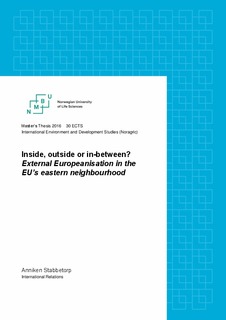| dc.description.abstract | The ways of promoting European values beyond Europe has changed. Instead of enlarging, the European Union (EU) now offers partnerships to its neighbours. Theories of European integration tend to focus on integration within the EU. The focus of this thesis, however, will be the members of the Eastern Partnership (EaP) and why they choose an integration option that formally leaves them on the outside of the EU. This thesis seeks to investigate how external governance theory explains why third party states become subjects of EU policy through external Europeanisation.
The EaP is the Eastern dimension of the European Neighbourhood Policy (ENP). It is a cooperation platform between the EU and six Eastern European states: Armenia, Azerbaijan, Belarus, Georgia, The Republic of Moldova and Ukraine. Conditionality is an important aspect of the EaP: The EU demands reform in the partner states in order to give them rewards.
External governance is the study of how states beyond Europe adapt EU rules, and how these rules are transferred. This research applies models of external governance to a comparative case study of three EaP states: Armenia, Georgia and the Republic of Moldova. The models are the external incentives model, the social learning model and the lesson-drawing model. The first model focuses on the costs and benefits of external governance, relative bargaining power, and determinacy and the size and speed of rewards. The second model focuses on similarity of identity, appropriateness of rules and the persuasive power of the external actor. The third model focuses on a dissatisfaction of the domestic status quo, which leads national policy makers to look abroad for solutions to their challenges. In the comparative case study, these models will explain the individual choices of the chosen cases.
When the models of external governance are applied to the case study, the conclusions are many. Firstly, it is difficult to be a small country between the EU and Russia, especially when you have two choose one of the two blocs. Secondly, the EU and the EaP states are rational actors who seek to maximise their own benefits through this cooperation. Therefore, they consider the cost and benefits of such agreements carefully before entering them. Thirdly, the case study shows that external governance theory accounts well for the partners choices as long as there is no cross-conditionality with competing external powers. As soon as Russia offers similar benefits or more apparent threats than the EU, external governance theory does not explain sufficiently the mechanisms behind the EaP states’ behaviour. | nb_NO |

